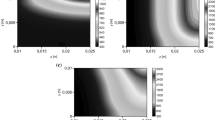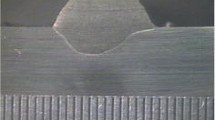Abstract
In the present paper, neural network-based expert systems have been developed for online predictions of temperature distributions on electron beam-welded plates. Finite element method is a popular tool to carry out this analysis. However, this analysis could be time consuming, and the obtained results might be dependent on a number of mesh parameters, namely shaping ratio, number of element divisions, and others. Thus, an expert system might be necessary for making online predictions of temperature distributions in welding after considering the said uncertainties. Neural network-based expert systems have been developed using the data collected through finite element analysis, and their performances are compared on some test cases. Once trained, the neural network-based expert systems could make the predictions in a fraction of a second.
Similar content being viewed by others
References
Subba Rao AV, Pratihar DK (2007) Fuzzy logic-based expert system to predict the results of finite element analysis. Knowl-Based Syst 20:37–50
Rosenthal D (1941) Mathematical theory of heat distribution during welding and cutting. Welding J 20(5):220–234
Couedel D, Rogeon P, Lemasson P, Carin M, Parpillon JC, Berthet R (2003) 2-D-heat transfer modeling within limited regions using moving sources: application to electron beam welding. Int J Heat Mass Transfer 46:4553–4559
Nguyen NT, Ohta A, Matsuoka K, Suzuki N, Maeda Y (1999) Analytical solutions for transient temperature of semi-infinite body subjected to 3-D moving heat sources. Weld J 78(8):265–274
Wei PS, Shian MD (1993) Three-dimensional analytical temperature field around the welding cavity produced by a moving distributed high-intensity beam. J Heat Transfer 115:848–855
He, DebRoy T (2003) Probing temperature during laser spot welding from vapor composition and modeling. J Appl Phys 94:6949–6958
Miyazaki T, Giedt WH (1982) Heat transfer from an elliptical cylinder moving through an infinite plate applied to electron beam welding. Heat Mass Transf 25:807–814
Baeva M, Baev P, Kaplan A (1997) An analysis of the heat transfer from a moving elliptical cylinder. J Phys D Appl Phys 30:1190–1196
Ho CY, Wei PS (1997) Energy absorption in a conical cavity truncated by spherical cap subject to a focused high-intensity beam. Int J Heat Mass Transfer 40:1895–1901
Brown SB, Song H (1992) Implications of three-dimensional numerical simulations of welding of large structures. Weld J 71:55s–62s
Brown S, Song H (1992) Finite element simulation of welding of large structures. J Eng Ind 114:441–451
Yanhong T, Chunqing W, Zhu D, Zhou Y (2008) Finite element modeling of electron beam welding of a large complex Al alloy structure by parallel computations. J Mater Process Technol 199:41–48
Gunaraj V, Murugan N (2000) Prediction and optimization of weld bead volume for the submerged arc process—Part 1. Weld J 78:286s–294s
Vasudevan M, Bhaduri AK, Baldev R, Rao PK (2007) Genetic algorithm based computational models for optimizing the process parameters of a TIG welding to achieve target bead geometry in type 304 L(N) and 316 L(N) stainless steels. Mater Manuf Processes 22:641–649
Holland J (1975) Adaptation in natural and artificial systems. The Univ. of Michigan Press, Ann Arbor
Correia DS, Gongalves CV, Sebastiao SC Jr, Ferraresi VA (2004) GMAW welding optimization using genetic algorithms. J Braz Soc Mech Sci Eng 26(1):28–31
Nagesh DS, Datta GL (2002) Prediction of weld bead geometry and penetration in shielded metal-arc welding using artificial neural networks. J Mater Process Technol 123:303–312
Dey V, Pratihar DK, Datta GL, Jha MN, Saha TK, Bapat AV (2009) Optimization of bead geometry in electron beam welding using a genetic algorithm. J Mater Process Technol 209:1151–1157
Dey V, Pratihar DK, Datta GL (2008) Prediction of weld bead profile using neural networks, Proc. of First International Conference on Emerging Trends in Engineering and Technology, ICETET, pp 581–586
Dey V, Pratihar DK, Datta GL (2010) Forward and reverse modeling of electron beam welding process using radial basis function neural networks. Int J Knowl Base Intell Eng Sys (in press)
ANSYS User’s guide for transient analysis, version 11. http://www.kxcad.net/ansys/ANSYS/ansyshelp/index.htm
Pratihar DK (2008) Soft computing. Narosa Publishing House Pvt. Ltd., New-Delhi
Author information
Authors and Affiliations
Corresponding author
Rights and permissions
About this article
Cite this article
Reddy, D.Y.A., Pratihar, D.K. Neural network-based expert systems for predictions of temperature distributions in electron beam welding process. Int J Adv Manuf Technol 55, 535–548 (2011). https://doi.org/10.1007/s00170-010-3104-6
Received:
Accepted:
Published:
Issue Date:
DOI: https://doi.org/10.1007/s00170-010-3104-6




